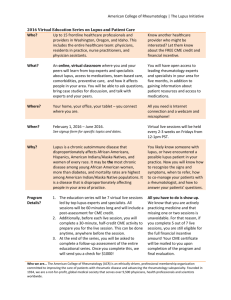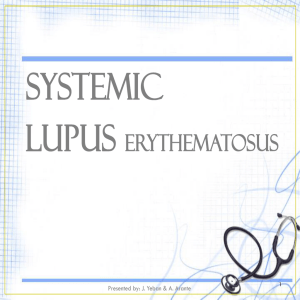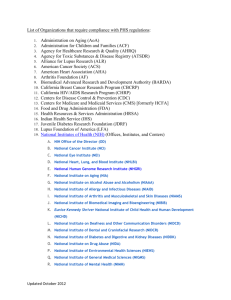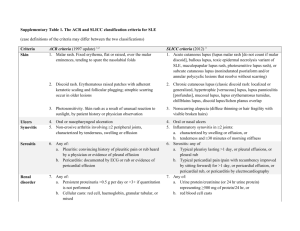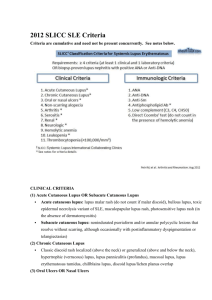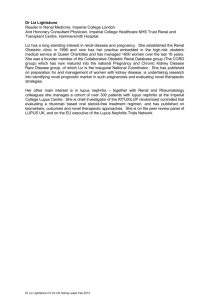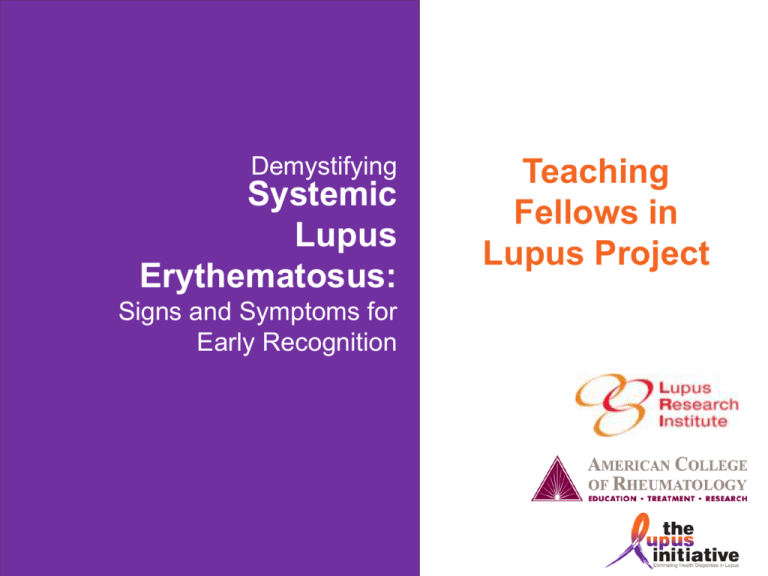
Demystifying
Systemic
Lupus
Erythematosus:
Signs and Symptoms for
Early Recognition
Teaching
Fellows in
Lupus Project
Introduction: Why are we here?
• Lupus can take 4-6 years and 3 providers before
diagnosis*
• During that time, organ damage can develop leading to 5
fold increased risk of death
• Patients go to primary care providers or emergency rooms
at onset of illness, so detection of lupus by these providers
is critical to early diagnosis
• These providers may have received only 90 minutes of
training on lupus in medical school*
* Survey data of health professionals
Abu-Shakra M, Urowitz MB, Gladman DD, Gough J. Mortality studies in systemic lupus erythematosus. Results from a single center.
II. Predictor variables for mortality. J Rheumatol. 1995;22(7):1265-1270.
How you can help: Teaching Fellows
Project
• Problem: Education about lupus is important for all providers,
but there is a shortage of peer educators
• Solution: Recruit fellows/junior faculty in Rheumatology to
serve as lupus educators for practicing physicians
• What you can do: Participate in the voluntary pre and post
assessment and follow up so we can evaluate the project
• Benefits to you: Increased self efficacy in lupus
detection, access to CMEs from the ACR
• Our goal: To bring this project to Rheumatology Fellowship
Programs nationally to expand quality education on lupus to
improve detection, increase appropriate referral, and decrease
diagnosis time
Pre/Post Assessment and Follow Up
Voluntary, Used solely to rate the quality of this seminar
De-identified: Linked by numeric identifier
• Pre- assessment (before seminar)
– 10 multiple choice or true/false questions and 1 efficacy question
– About 3 minutes to complete
• Post- assessment (after seminar)
– Repeat pre assessment
– Additional qualitative and demographics questions
– About 5 minutes to complete
• Follow up assessment (4-6 weeks after seminar)
– Repeat pre assessment
– Option for comment
– Requires an email address
• Access to CME modules available from ACR for completion
• Answers available after session
Thank you
We appreciate your time in taking our pre seminar
assessment
Presentation Goals
• To improve recognition of lupus and increase appropriate
referral for diagnosis by:
• Increasing lupus knowledge in:
– Epidemiology
– Health Disparities
– Genetics, Pathogenesis, ANA and other Autoantibodies
– Disease characteristics: activity, severity, mortality
• Reviewing the classification criteria
• Discussing real case presentations of patients with lupus
Patient Voices
Systemic Lupus Erythematosus (SLE)
• An inflammatory, multisystem, autoimmune disease of
unknown etiology with protean clinical and laboratory
manifestations and a variable course and prognosis
• Lupus can be a mild disease, a severe and
life-threatening illness, or anything in between
• The diversity of clinical symptoms in SLE is great, and all
organ systems are vulnerable
• Disease is characterized by periods of flare
and remission (or low level activity) and can culminate in
irreversible end-organ damage
Why is diagnosis so hard?
• The Great Masquerader: can mimic viral syndromes,
malignancies, allergic reactions, stress, etc.
• May be associated with depression and/ or fibromyalgia.
• Initial symptoms might be non-specific: fatigue, achiness,
stiffness, low grade fevers, swollen lymph nodes, rashes.
• Symptoms may develop slowly or suddenly.
• There is no gold standard diagnostic test for lupus
• Wide variety of symptoms and organ involvement may be
present.
Examples of Organs Involved,
Signs, and Symptoms
Eyes
Central nervous
system
Skin
Oral & nasal ulcers
Pleurisy
Kidney
disease
Muscle
Raynaud’s &
vasculitis
Medical Illustration Copyright © 2012. Nucleus Medical Media. All rights reserved.
Pericarditis
Blood
disorders
Joints & arthritis
Why is early referral important?
• Mortality is higher in lupus patients compared to the general
population
• 5-year survival rate in 1953 was 50%, increased to 90% with
better detection and treatment
• Currently 80 to 90% of lupus patients survive 10 years after
diagnosis, but that drops to 60% with advanced stages of organ
threatening disease
• Leading causes of mortality are preventable
• Appropriate therapeutic management, compliance with
treatment and improved treatment of long-term consequences
can prevent excess and premature deaths. This starts with
clinical suspicion of the diagnosis and early recognition.
American College of Rheumatology Ad Hoc Committee on Systemic Lupus Erythematosus. Guidelines for referral and management of
systemic lupus erythematosus in adults. Arth Rheum 1999;42:1785--96
Mortality
• Cardiovascular disease is the major cause of mortality in
patients with longstanding lupus
• Factors contributing to increased mortality*
-
Active lupus & infection (early stages of disease)
High disease severity at diagnosis
Younger age at diagnosis
Ethnicity: Black, Hispanic, Asian, and Native American populations
Male gender
Low socioeconomic status
Poor patient adherence*
Inadequate patient support system*
Limited patient education*
*Indicates opportunity for improvement.
Bernatsky S, Boivin JF, Joseph L, et al. Arthritis Rheum. 2006;54:2550-2557.
Epidemiology
• Prevalence: 2–140/100,000 worldwide but as high as 207/100,000
• Incidence: 1–10/100,000 worldwide
• Health Disparities and At-Risk Populations:
– Women in their reproductive years
– Women are 9 times more likely to develop lupus than men
– Non-Caucasians have the highest prevalence:
■ Affects up to 1/250 Black women in US
■ 2-3 times higher risk than white women
• Cost: Direct costs associated with treatment (e.g., $100 billion in
healthcare cost associated with autoimmune diseases) and indirect
cost related to lost productivity and wages
Helmick CG, Felson DT, Lawrence RC, et al. Arthritis Rheum. 2008;58(1):15-25; Chakravarty EF, Bush TM, Manzi S,
Clarke AE, Ward MM. Arthritis Rheum. 2007;56(6):2092-2094; Fessel WJ. Rheum Dis Clin North Am. 1988;14(1):15-23.
Other Health Disparities in Lupus
• Specific racial/ethnic minorities are more likely to develop
lupus at a younger age and to have more severe
symptoms at onset
• Specific racial/ethnic minorities with lupus have mortality
rates at least 3 times as high as White individuals
• Low income individuals less likely to receive
recommended care
• Poverty associated with poor outcomes
Duran S, Apte M, Alarcón GS. J Natl Med Assoc. 2007;99(10):1196-1198; Ward MM, Pyun E, Studenski S. Arthritis
Rheum. 1995;38(2):274-283; Alarcón GS, McGwin G Jr, Bastian HM, et al. Arthritis Rheum. 2001;45(2):191-202.
McCarty DJ, Manzi S, Medsger TA Jr, Ramsey-Goldman R, LaPorte RE, Kwoh CK. Arthritis Rheum.
1995;38(9):1260-1270; Cooper GS, Parks CG, Treadwell EL, et al. Lupus. 2002;11(3):161-167.
CDC. MMWR Morb Mortal Wkly Rep. 2002;51:371-374.
Disease Activity and Severity
• Predictors of flare (in some but not all cases)
– New evidence of complement consumption
– Rising anti-dsDNA titers
– Increased ESR
– New lymphopenia
• Severity characterized by:
– Abrupt onset of symptoms
– Increased renal, neurologic, hematologic, and serosal
involvement
– Rapid accrual of damage (irreversible organ injury)
– Associated with race, younger age, male gender, poverty
SLE
Genetic
alterations
Initiation
Amplification
Perpetuation
Environmental
Exposures &
Behavior
Abnormally functioning
B-cells
T-cells
pDC
Autoantibodies
ICs
Proinflammatory
molecules
TISSUE INJURY
Antigen
Hormones
(estrogen)
Infections
Toxins
Medications
Sun exposure
Vitamin D deficiency
Smoking
Stress
Toxins
Medical Illustration Copyright © 2012
Nucleus Medical Media. All rights reserved.
Pathogenesis of Lupus- Important
Concepts
• Autoimmunity is an altered immune homeostasis that
leads to autoreactivity, immunodeficiency, and
malignancy.
• Immune dysregulation leading to autoreactivity and
autoantibodies in SLE occurs in different phases and
likely represents the untoward effects of environmental
triggers on the genetically susceptible host.
Lupus Intangibles
Achiness, Headache
Fatigue
Memory thief
“brain fog”
Depression
Lupus on the Outside
Synovitis
Discoid rash
Malar rash
Jaccoud’s arthropathy
Painless oral
ulcer
Vasculitis
Raynaud’s
Phenomenon
Alopecia
Lupus on the Inside
Serositis
Pericardial
effusion
Cerebral infarct
Brain atrophy
Spherocytes
Glomerulonephritis
C
What Do Most Lupus Patients Have in
Common—Antinuclear Antibodies (ANA)
• Autoantibodies against various components of the cell
nucleus
• Present in many autoimmune disorders as well as some
healthy subjects
• Sensitive (not specific for SLE)
• Because of low specificity, ANA usefulness increases if
the pretest probability for lupus is high; ie, the patient has
symptoms and signs that can be attributed to SLE
• Because of the high sensitivity of the ANA, a patient with
negative ANA is unlikely to have lupus even when her/his
clinical presentation is suggestive of lupus
Incidence of Positive ANA
• Non- lupus subjects 3%−4%
• SLE 95%−99%
• Scleroderma 95%
• Hashimoto’s thyroiditis 50%
• Idiopathic pulmonary fibrosis 50%
• Incidence increases with age, chronic infections,
and other chronic conditions
• Interpret the ANA in context of clinical complaints
ANA+ does not = SLE
Autoantibodies in SLE
Antibodies
Lupus
Specificity
Clinical Associations
ANA
Low
Nonspecific
Anti-dsDNA
High
Nephritis
Anti-Sm
High
Nonspecific
Anti-RNP
Low
Arthritis, myositis, lung disease
Anti-SSA
Low
Dry eyes/mouth, subacute cutaneous lupus
erythematosus (SCLE), neonatal lupus,
photosensitivity
Anti-SSB
Low
Same as above
Intermediate
Clotting diathesis
Antiphospholipid
When to suspect SLE:
ACR (Revised) Criteria for Classification
4/11= 95% Specificity; 85% Sensitivity
1.
2.
3.
4.
5.
6.
Serositis
Oral ulcers
Arthritis
Photosensitivity
Blood cells
Renal involvement
7. Antinuclear
antibodies (ANA)
8. Immunologic
disorder
9. Neurologic disorder
10. Malar rash
11. Discoid rash
Tan EM, Cohen AS, Fries JF, et al. Arthritis Rheum. 1982;25:1271-1277. Hochberg MC. Arthritis Rheum. 1997;40:1725. [Letter].
Signs and Symptoms
Symptom Occurrence (ever)
Neurologic
Arthralgias
Fever >100 F (38 Degrees C)
Arthritis
Prolonged or extreme fatigue
Skin rashes
Anemia
Kidney involvement
Pleurisy and/or pericarditis
Butterfly-shaped rash across cheeks and nose
Sun or light sensitivity (photosensitivity)
Hair loss
Abnormal blood clotting problems
Raynaud’s phenomenon
Siezures
Mouth or nose ulcers
90%*
95%
90%
80%
81%
74%
71%
50%
45%
42%
30%
27%
20%
17%
15%
12%
Case Presentation A
• History: A 23-year-old Hispanic female
with no past medical history presented to
the emergency department (ED) with an
8-week history of joint pain and swelling in
the hands, knees, and ankles; fever; myalgias; pleuritic
chest pain; weight loss; and a facial rash that worsened
with sun exposure. She had been seen initially at a local
clinic and treated for “cellulitis” with oral Keflex. Two days
prior, she was seen in another ED, found to have a
temperature of 103 F, proteinuria, and anemia; she was
told it was a “viral syndrome” and discharged home.
Case Presentation A (cont.)
• Exam: T 37.9 C, BP 130/90, painless
ulceration on the palate,
malar rash, diffuse lymphadenopathy,
and synovitis of the MCP/PIP joints
• Labs: WBC 2.5x109/L, total protein 9 g/dL,
albumin 3 g/dL, Hgb 11g/dL, Hct 32%, BUN 11 mg/dL,
Cr .06 mg/dL
UA: 100 mg/dL protein, RBC 20–40/hpf, WBC 0–1/hpf
ANA+, anti-dsDNA+, Sm+
Case Presentation B - What features are
concerning for lupus?
• 23 year old woman from Western Africa with recently
diagnosed anemia (presumed but not confirmed to be
iron-deficiency anemia) presents with swelling of feet and
hands and a non-specific rash on her face and arms. She
reported swelling in the joints, enlarged lymph nodes,
generalized body aches and sweating.
• Chart review reveals:
– Positive ANA of 1:1280
– 4.2 WBC with normal differential
– Hb/Hct is 9.6/30.4 MCV 77.3
– Plt 307
Lupus Detection—In Summary
• Early symptoms can be
– Non-specific, easily confused with other illnesses or
syndromes
– Transient or prolonged, independent of one another
• Consider lupus if your patient presents with
– Vague complaints from the signs and symptoms list
– Family history of autoimmune disease
• Do an initial screening
– CBC, BMP, LFT’s, ESR, CRP, ANA, UA
• Make a referral for assessment and diagnosis by a
Rheumatologist
Final Thoughts
• Patient engagement and trust building is critical
– Patients from different cultural/socioeconomic
backgrounds experience illness and treatment differently
– Physicians from different cultural/socioeconomic
backgrounds perceive patients and symptoms differently
• What you can do to reduce health disparities
– Discuss lupus prevalence and disparities with colleagues
– Pursue continuing education about causes of disparities
and cross-cultural communication
– Learn about and refer patients to community resources
Resources and Information
Ongoing care of lupus patients is a team effort
For presentations, videos, interactive case studies and
CE/CME courses that can help, visit the Lupus Initiative at
www.tlitools.org
We appreciate your participation in the post assessment and 4-6
week follow up assessment
Thank you!
This project is part of the American College of Rheumatology’s Lupus
Initiative (www.tlitools.org) and is administered by the Lupus
Research Institute (lupusresearchinstitute.org/).
This project is supported by Grant Number 1 CPIMP141065-01-00
from the U.S. Department of Health and Human Services office of
Minority Health.
Questions about the Project?
Contact Amy Caron
Lupus Research Institute
acaron@lupusny.org
212-812-9881 Ext. 39


